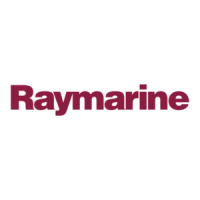2-22
hsb
2
Plus Series Fishfinders
SeaTalk and NMEA
In
SeaTalk and NMEA In
The
hsb
2
Plus Series display can receive a comprehensive range of data. The
primary data is described below:
Heading data should ideally contain both magnetic and true heading. If only
one is available then a source of magnetic variation should be connected.
Radars and chartplotters can exchange their cursors via SeaTalk. Locked
heading should be used for Course Up if available via SeaTalk. Other data
connected via a SeaTalk bus or via NMEA is generally displayed in data
boxes, e.g., depth, apparent wind angle and speed, time.
Note: The Fishfinder uses its own depth data, rather than any other depth data
on SeaTalk. If there is no other depth data on SeaTalk, Fishfinder depth is
transmitted. If speed and temperature data are available on SeaTalk the Fish-
finder uses this data; if this data is not on SeaTalk from other instruments, it is
transmitted by the Fishfinder.
For details of received data refer to the table in Appendix D: SeaTalk and
NMEA Data. Examples of SeaTalk and NMEA systems are shown in
Figure 2-13 and Figure 2-14.
Table 2-4: Function of SeaTalk and NMEA Data
Data Primary Uses Suggested Source
Heading Chart: modes/ vectors Compass connected to SeaTalk bus,
NMEA Compass
Position Chart: own vessel position
MOB (also requires speed and HDG
data)
SeaTalk GPS connected via Auxiliary JB
Existing GPS Navigator via SeaTalk bus
Existing GPS (or Loran-C) navigator with
NMEA output
Waypoint Chart: Waypoint and route transfer Existing GPS Navigator via SeaTalk bus
Existing GPS (or Loran-C) navigator with
NMEA output

